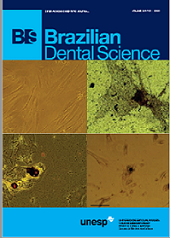Preventive and therapeutic effects of relaxin on bisphosphonaterelated osteonecrosis of the jaw: an experimental study in rats
DOI:
https://doi.org/10.14295/bds.2020.v23i1.1846Abstract
Objective: Bisphosphonate-related osteonecrosis of the jaw (BRONJ) is a challenging complication of chronic bisphosphonate (BP) use. The hormone relaxin is able to induce the multistep differentiation process of human osteoclastogenesis, exhibits anti-fibrotic and anti-inflammatory actions, and promotes vasodilatation, wound healing, and angiogenesis. The present study aimed to evaluate the effects of relaxin in the prevention and management of BRONJ. Material and Methods: Thirty-six male Sprague Dawley rats were randomly divided into four groups. Rats in group 1 (n = 10) received relaxin and BP simultaneously for 12 weeks. Rats in group 2 (n = 10) received injections of BP for 12 weeks, followed by relaxin for another 12 weeks. Rats in group 3 (n = 10) received only BP injections, and those in group 4 (control, n = 6) received only saline. Necrosis and inflammation in the rats’ mandibles were evaluated as indicators of BRONJ. Results: Necrosis and inflammation were not detected in group 1 (BP + relaxin). In group 3 (BP only), incidence rates of necrosis and inflammation were 90% and 60%, respectively. Conclusions: Our findings suggest that relaxin may be potently effective in preventing BRONJ and have some benefit in the treatment of existing BRONJ.
KEYWORDS
Animal model; BRONJ; Relaxin.
Downloads
Downloads
Published
How to Cite
Issue
Section
License
Brazilian Dental Science uses the Creative Commons (CC-BY 4.0) license, thus preserving the integrity of articles in an open access environment. The journal allows the author to retain publishing rights without restrictions.
=================
COPYRIGHT TRANSFER AND RESPONSIBILITY STATEMENT
(PDF)
For all articles published in the BDS journal, copyright is retained by the authors. Articles are licensed under an open-access Creative Commons CC BY 4.0 license, meaning that anyone may download and read the paper for free. In addition, the article may be reused and quoted, provided that the original published version is cited. These conditions allow for maximum use and exposure of the work while ensuring that the authors receive proper credit. All metadata associated with published articles is released under the Creative Commons CC0 Universal Public Domain Dedication.
Before the submission, authors must obtain permission to reproduce any published material (figures, schemes, tables, or any extract of a text) that does not fall into the public domain or for which they do not hold the copyright. Permission should be requested by the authors from the copyright holder (usually the Publisher, please refer to the imprint of the individual publications to identify the copyright holder).
The authors hereby attest that the study is original and does not present manipulated data, fraud, or plagiarism. All names listed made a significant scientific contribution to the study, are aware of the presented data, and agree with the final version of the manuscript. They assume complete responsibility for the ethical aspects of the study.
This text must be printed and signed by all authors. The scanned version should be submitted as supplemental file during the submission process.
























